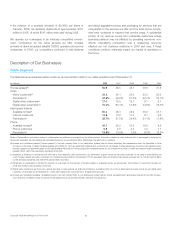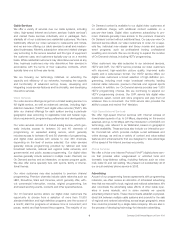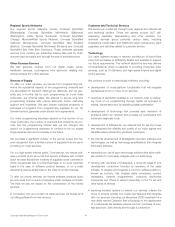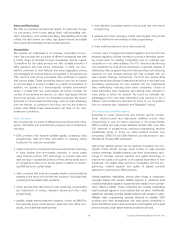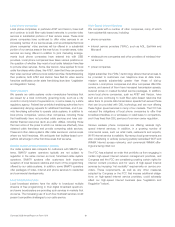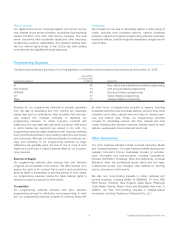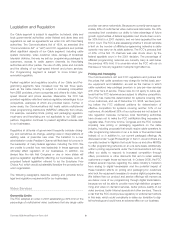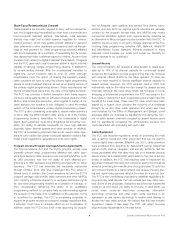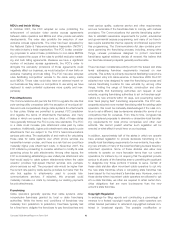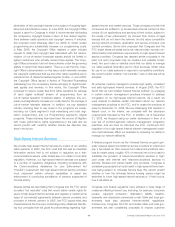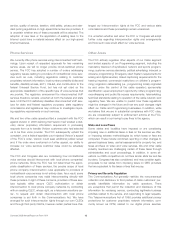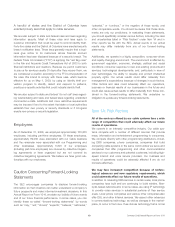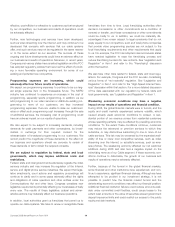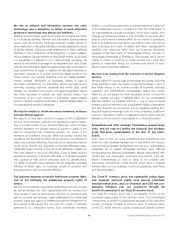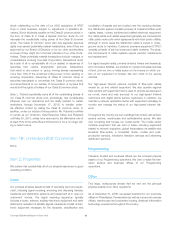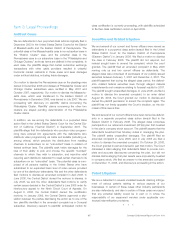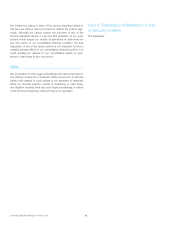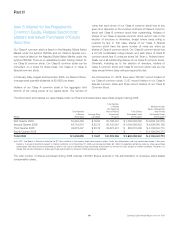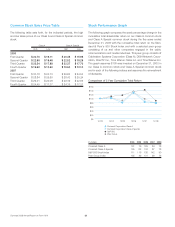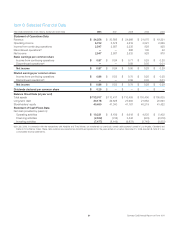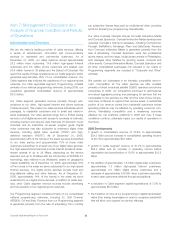Comcast 2008 Annual Report Download - page 14
Download and view the complete annual report
Please find page 14 of the 2008 Comcast annual report below. You can navigate through the pages in the report by either clicking on the pages listed below, or by using the keyword search tool below to find specific information within the annual report.
service, quality of service, taxation, child safety, privacy and stan-
dard pricing regulations on high-speed Internet service providers. It
is uncertain whether any of these proposals will be adopted. The
adoption of new laws or the application of existing laws to the
Internet could have a material adverse effect on our high-speed
Internet business.
Phone Services
We currently offer phone services using interconnected VoIP tech-
nology. Upon receipt of requested approvals for two remaining
service areas, we will no longer provide circuit-switched phone
service. The FCC has adopted a number of orders addressing
regulatory issues relating to providers of nontraditional voice serv-
ices such as ours, including regulations relating to customer
proprietary network information, local number portability duties and
benefits, disability access, E911, CALEA, and contributions to the
federal Universal Service Fund, but has not yet ruled on the
appropriate classification of the specific type of voice services that
we provide. The regulatory environment for interconnected VoIP
services therefore remains uncertain at both the federal and state
level. Until the FCC definitively classifies interconnected VoIP serv-
ices for state and federal regulatory purposes, state regulatory
commissions and legislatures may continue to investigate impos-
ing regulatory requirements on such services.
We and two other cable operators filed a complaint with the FCC
against Verizon in 2008 claiming that Verizon had violated a stat-
utory carrier proprietary information requirement in processing
requests from us to transfer Verizon customers who had selected
us to be their voice provider. The FCC subsequently upheld the
complaint, and a federal appellate court rejected Verizon’s appeal
of the FCC’s order. Verizon could seek additional judicial review
and, if the order were overturned on further appeal, our ability to
increase our voice services customer base could be adversely
affected.
The FCC and Congress also are considering how nontraditional
voice services should interconnect with local phone companies’
phone networks. Since the FCC has not determined the appro-
priate classification of these services, the precise scope of local
phone company interconnection rules applicable to providers of
nontraditional voice services is not entirely clear. As a result, some
local phone companies may resist interconnecting directly with
these providers. In light of these concerns, providers of these serv-
ices typically either secure CLEC authorization or obtain
interconnection to local phone company networks by contracting
with an existing CLEC, whose right, as a telecommunications car-
rier, to request and obtain interconnection with local phone
companies is set forth in the Communications Act. We have
arranged for such interconnection rights through our own CLECs
and through third party CLECs, however certain parties have chal-
lenged our interconnection rights at the FCC and various state
commissions and these proceedings remain unresolved.
It is uncertain whether and when the FCC or Congress will adopt
further rules regarding interconnection rights and arrangements
and how such rules would affect our voice services.
Other Areas
The FCC actively regulates other aspects of our Cable segment
and limited aspects of our Programming segment, including the
mandatory blackout of syndicated, network and sports program-
ming; customer service standards; political advertising; indecent or
obscene programming; Emergency Alert System requirements for
analog and digital services; closed captioning requirements for the
hearing impaired; commercial restrictions on children’s program-
ming; origination cablecasting (i.e., programming locally originated
by and under the control of the cable operator); sponsorship
identification; equal employment opportunity; lottery programming;
recordkeeping and public file access requirements; telemarketing;
technical standards relating to operation of the cable network; and
regulatory fees. We are unable to predict how these regulations
might be changed in the future and how any such changes might
affect our Cable and Programming businesses. In addition, while
we believe that we are in substantial compliance with FCC rules,
we are occasionally subject to enforcement actions at the FCC,
which can result in our having to pay fines to the agency.
State and Local Taxes
Some states and localities have imposed or are considering
imposing new or additional taxes or fees on the services we offer,
or imposing adverse methodologies by which taxes or fees are
computed. These include combined reporting or other changes to
general business taxes, central assessments for property tax, and
taxes and fees on video and voice services. We and other cable
industry members are challenging certain of these taxes through
administrative and court proceedings. In addition, in some sit-
uations our DBS competitors do not face similar state tax and fee
burdens. Congress has also considered, and may consider again,
proposals to bar states from imposing taxes on DBS providers
that are equivalent to the taxes or fees that we pay.
Privacy and Security Regulation
The Communications Act generally restricts the nonconsensual
collection and disclosure to third parties of cable customers’ per-
sonally identifiable information by cable operators. There
are exceptions that permit the collection and disclosure of this
information for rendering service, conducting legitimate business
activities related to the service, and responding to legal requests.
The Telecommunications Act of 1996 provides additional privacy
protections for customer proprietary network information, com-
monly known as CPNI, related to our digital phone services.
Comcast 2008 Annual Report on Form 10-K 12


